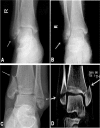Radiographic analysis of adult ankle fractures using combined Danis-Weber and Lauge-Hansen classification systems
- PMID: 32376947
- PMCID: PMC7203210
- DOI: 10.1038/s41598-020-64479-2
Radiographic analysis of adult ankle fractures using combined Danis-Weber and Lauge-Hansen classification systems
Abstract
This study was to analyze ankle fractures for determining the epidemiology, types, distribution, possible mechanisms and diagnosis precision. Between January 2013 and December 2017, all Chinese patients older than 16 years of age with ankle fractures excluding old ankle fractures and pathological fractures in a tertiary care hospital were analyzed by using the Danis-Weber and Lauge-Hansen classification systems. Among 3952 patients with ankle fractures, 1225 fractures (31%) were Danis-Weber type A, 1640 (42%) were type B, 751 (19%) were type C, and 336 (9%) were perpendicular compression fracture. There were 1949 fractures on the left side and 2003 on the right with no significant difference (P > 0.05). Male patients between 16 and 50 years of age and women over 50 years had a higher incidence of ankle fractures accounting for 38.4% (1517/3952) and 22.2% (800/3952), respectively. Posterior malleolar fractures, fibular fractures above the inferior tibiofibular joint and Tillaux fractures were easily missed in the diagnosis, with 38 fractures (0.96%) being missed in the diagnosis. In conclusion, young and middle-aged men and older women have a higher incidence of ankle fractures, and use of the Lauge-Hansen and Danis-Weber classification systems can better help assessing the varied and complex ankle fractures, predicting the injuries, increasing diagnostic precision and decreasing misdiagnosis rate.
Conflict of interest statement
The authors declare no competing interests.
Figures







References
MeSH terms
LinkOut - more resources
Full Text Sources
Medical

